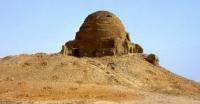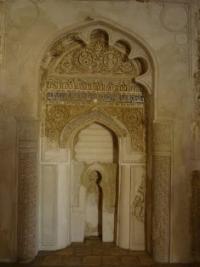Вы здесь
Shir-Kabir mosque-mausoleum.




Excursion in Shir Kabir mosque-mausoleum.
“I've known rivers:
I've known rivers ancient as the world and older than the flow of human blood in human veins. My soul has grown deep like the rivers”
Langston Hughes.
Tours on monuments of Dekhistan.
The Shir-Kabir mosque-mausoleum is located on an ancient necropolis, at an altitude of 152 meters above sea level, located in the southern part of the Choganly plain, in the northwestern part of the Khurmen sands, 22.6 kilometers north and slightly west of the village of Madau, 9 , 2 kilometers to the north and slightly east of the settlement of Dehistan in the Etrek etrap of the Balkan velayat.
The mosque at the burial of Sheikh Ali ibn Sukkar. This centric dome building built out of raw sugar. Outside the cube-shaped housing is terraced spheroid transition to the dome. The interior has a three-part division: panel, wall, advanced sail design cupola.
In the niche of the mihrab, the panel remains of the dome of the rich carved piece with stylized floral motifs and inscriptions in Arabic Kufic script writing. Around the mosque to the cemetery are nameless mausoleum (XI - XII centuries).
Built of baked bricks. They oktogonalnye or circular in plan, heavy proportions, covered domes have very advanced arched entrances. Although the date of construction, patron and architect of the shrine is unknown, historians have dated it between the ninth and the eleventh century based on comparisons with stylistically similar structures.
The shrine was modified and restored numerous times, including twelfth century additions to the north of the shrine and seventeenth and eighteenth century rebuilding of the main dome and brick paneling of the mud-brick walls.
Today, the main dome is only half standing with some reconstruction underway. The present day plan of the shrine is roughly oriented north to south. The domed, square burial chamber is placed off-center to the west, between two smaller square rooms attached to its northeast and northwest corners.
These rooms may have been connected with a roof, forming a portico. While the remaining walls of the northeastern room are articulated with three arched niches, little can be said about the northwest room, of which little remains.
While the entrance to the burial chamber is offset to the west on its north façade, the smaller rooms were accessed through their facing west and east façades. The ensemble is constructed out of mud brick, with complete brick facing on the exterior.
The interior walls of the burial chamber are plastered in white and have three arched niches carved into them. One of the three niches on the northern wall serves as the entrance. The central niche of the southern wall serves as the mihrab and is differentiated with two nestled arches.
The lower arch has Quranic inscriptions carved in relief, framed with vegetal and geometric decorative patterns. The upper multifoliate arch (now damaged) has verses from the Ayat al-Kursi. Traces of inscriptive stucco plaques painted in blue, green and red are seen on the other niches.
The base of the dome also had an inscriptive band above the four squinches, which help transition to the octagonal drum. Arched niches have been carved into the walls of the drum between the squinches. The interior height of the room, from the floor to the tip of the dome, is roughly eleven meters.
Geographic coordinates of the Shir Kabir mosque-mausoleum: N38 ° 19'40.30 "E54 ° 39'07.73"
Authority:
Sayan, Yüksel. 1999. Türkmenistan'daki Mimari Eserler (XI - XVI Yüzyil). Ankara: Kültür Bakanligi Yayinlari, 39-42; 313-317.







